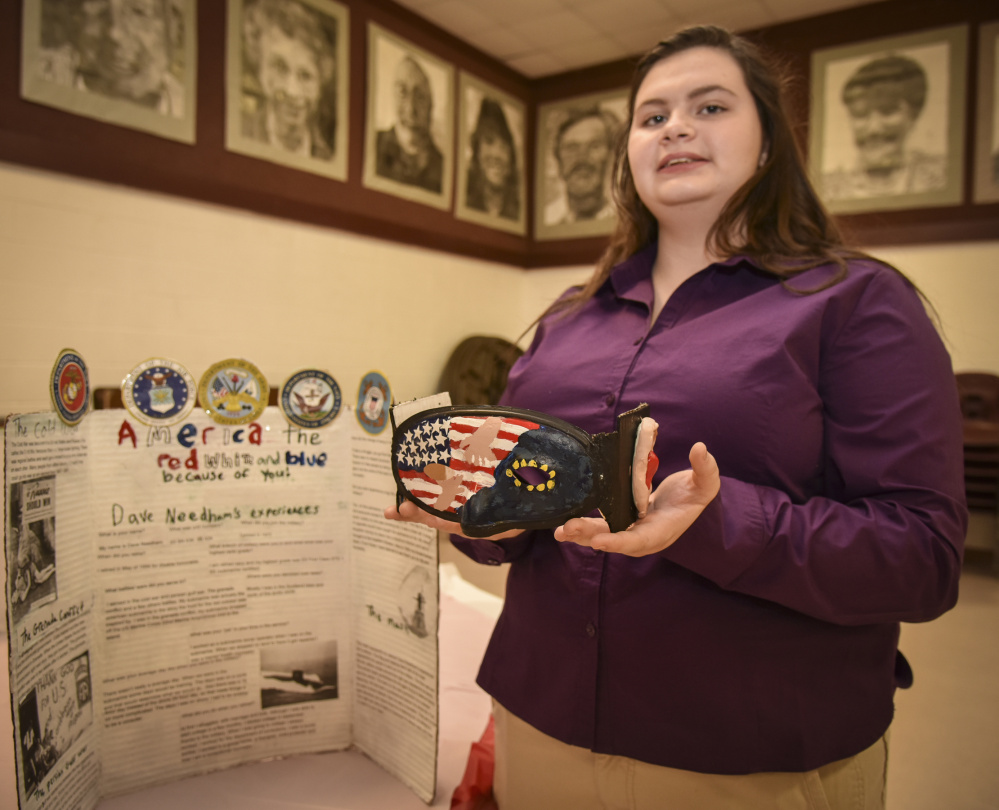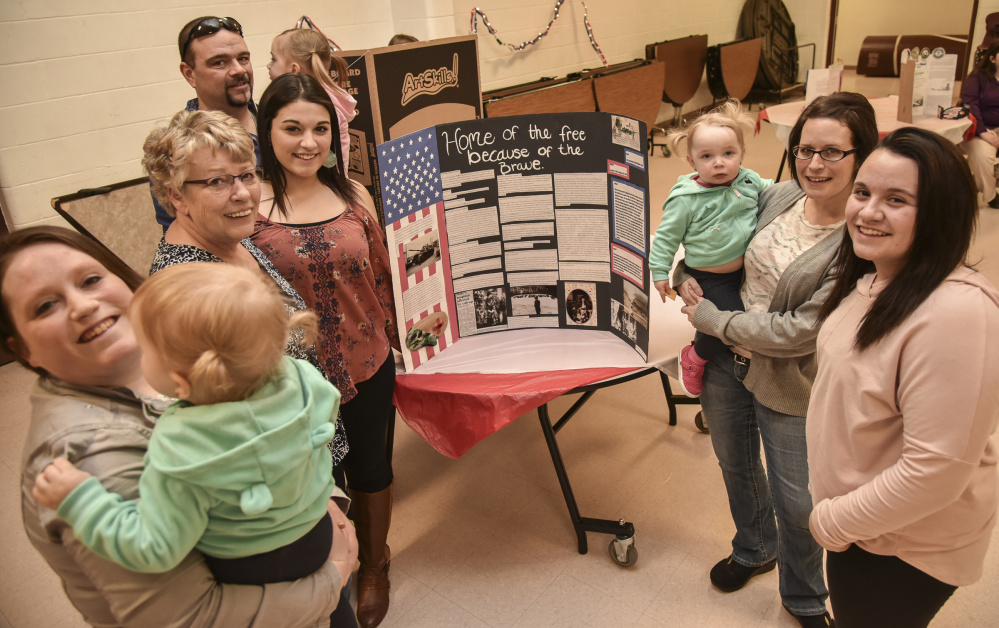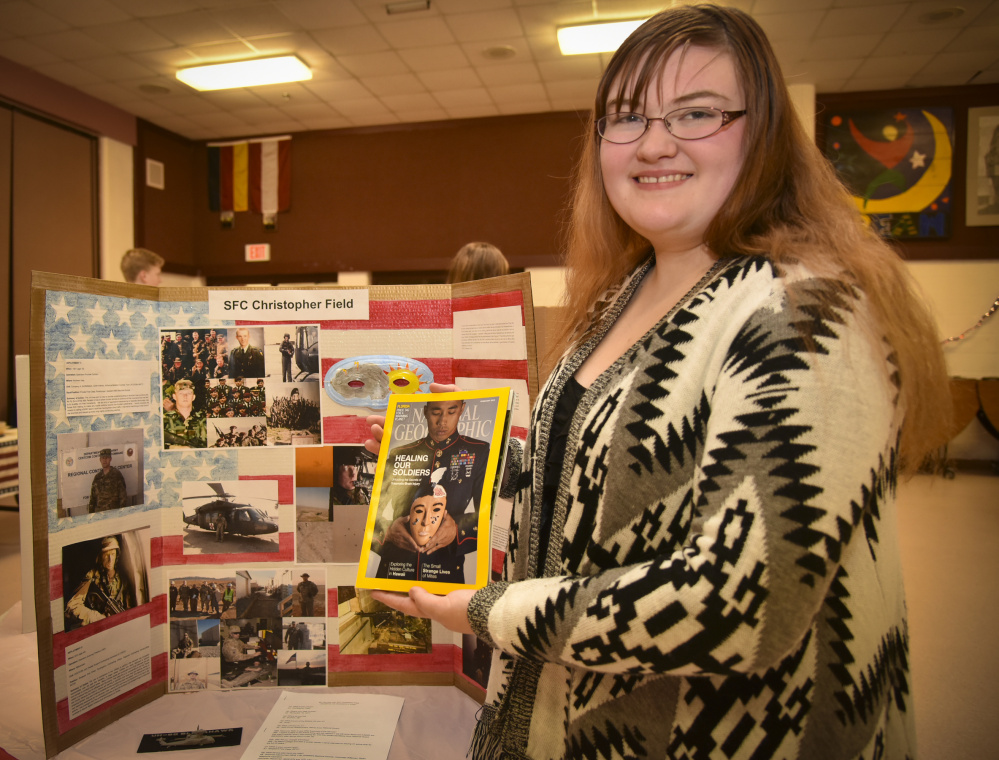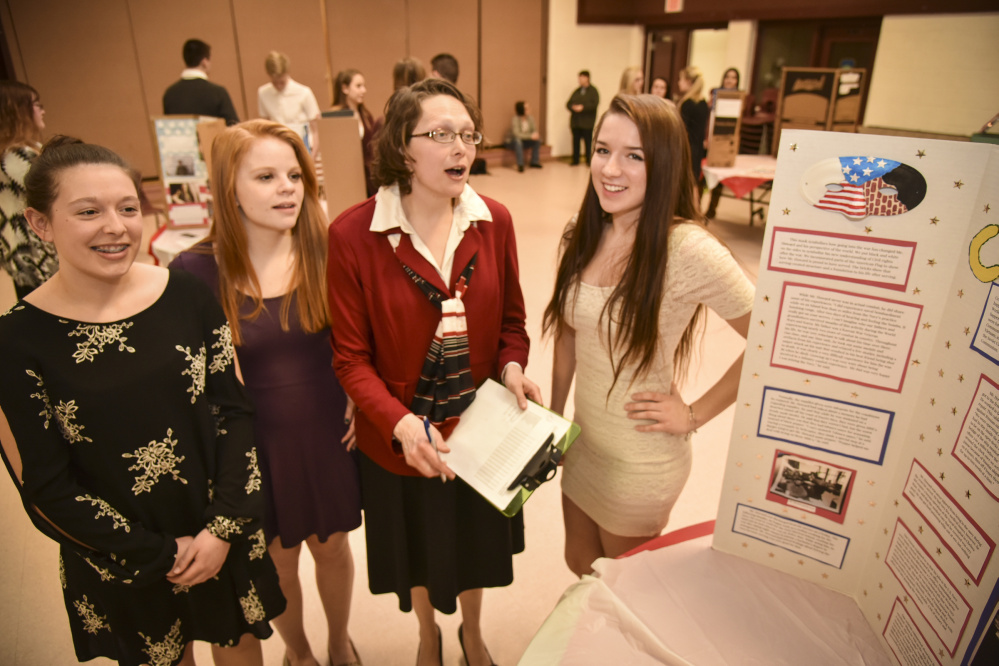MONMOUTH — Olivia Caron knew her grandmother, Crystal Guerrette, had served in the Army, but until she took on a U.S. Studies class project, the Monmouth Academy sophomore didn’t know one of the biggest reasons why she served 28 years in the Army was to honor her father.
In an interview for a class project in which students interviewed military war veterans about their service and experiences, Caron was told by her grandmother she had joined the Army, serving stateside as a medical nurse for 28 years including during Operation Desert Storm, to honor her father, who enlisted in the military but had to leave before his service was up to care for his mother who got cancer.
“She was proud to serve for him,” Caron said.
Caron said she also learned about some of the difficulties of being a woman serving in times of military conflict.
Students, after interviewing local veterans as part of the project, took the information they learned from them and did some research into what they talked about. They presented their research, in words and photographs and artwork, Monday night in “The Masks of War” presentation.
The masks piece of the project added an art component. Students were given plain face masks and told to paint them to reflect what they’d learned about their veterans’ experiences and how they had been changed by war.
Caron’s mask had camouflage on one side of the mask, to reflect how proud her grandmother was to wear her uniform, dark skin-colored on the other side, to reflect that Guerrette saw dirty things during her service, and a red cross to reflect that she was a nurse.
Student Jessica Withee interviewed Dave Needham, a co-worker of her mother, about his service in the Navy during the Cold War, Grenada Conflict and Persian Gulf War. The mask she did for the project included an American flag motif on one side with helping hands on it and 10 dots circling an eye of the mask surrounded by a blue sea. The mask comes complete with big ears on its sides, one of them with a heart inside it.
She said the helping hands reflect that Needham, who served as a sonar technician on submarines and later as a counselor, valued helping others; the 10 dots were for Needham’s 10 family members and reflected, she said, “the struggle of taking care of your family while still doing your job”; and the ears reflected that he, in both his jobs, was a professional listener. The heart in one ear, she said, was in part because the heart was on the same side of the mask as his family and because “he always says to listen to your heart.”
Social studies teacher Jocelyn Gray, whose own husband is a veteran of the war in Iraq and whose family has had many people serve in the military, said part of the inspiration for the project came to her after she read a National Geographic article about soldiers who suffered brain injuries from blasts in Iraq and Afghanistan and who, guided by an art therapist, painted images on masks to symbolize themes from their experiences, such as death, pain, and patriotism.
Students also read the article before doing their projects. Then they each interviewed a veteran, preferably someone they already had a relationship with. She said nearly all students were related to, or knew, a veteran, though many said they’d never talked with them about their war experiences. Some students reported they knew a veteran but that person told them they weren’t comfortable being interviewed.
Gray said she warned the high school students to anticipate that some veterans would not want to talk about their experiences. Multiple students interviewed teachers.
Julia Johnson, Cheyenne Pease, and Mariah Herr interviewed Tom Menendez, their math teacher when they attended Monmouth Middle School. Menendez served in the Army in Vietnam.
Pease said Menendez acknowledged he lost some friends in the war, but he didn’t really want to talk about that.
But Johnson said he also described going to Vietnam as kind of like a vacation, a chance to get away.
Their mask included a helicopter in a war zone on one side, and a beach and palm trees on the other.
Sierra Cummins interviewed Army Sgt. Christopher Field, a friend of her mom who works at Camp Keyes and has deployed, following conflicts, to Iraq, Kuwait and Afghanistan.
She said she learned a lot about the life of a soldier. She said Field is a “happy go lucky guy” who said he didn’t suffer major negative impacts during his service, but was changed by his service, including now not being fond of loud noises.
The mask she made after interviewing him featured sunshine and blue sky on much of the mask, but with a cloud and lightning bolts on its side.
McKenzie Stevens, Valerie Fullerton and Elizabeth Mason interviewed Richard Howard, a substitute teacher at the school who served in the Navy during the Cold War.
They said Howard told them he had a largely positive experience while serving. Their mask was painted in a red, white and blue motif to reflect Howard’s patriotism with a brick wall because he told them his service provided structure in his life, and with white on one side and black on the other, because Howard told them his service opened his eyes to more aspects of the world, including civil rights.
Each student interviewed Monday about their interviews said they learned a lot in the project.
“I learned a lot about what some people had to go through,” Withee said. “Like what it felt like when they got back. I learned we need to have more respect for them, because they went through so much.”
Keith Edwards — 621-5647
Twitter: @kedwardskj
Send questions/comments to the editors.







Success. Please wait for the page to reload. If the page does not reload within 5 seconds, please refresh the page.
Enter your email and password to access comments.
Hi, to comment on stories you must . This profile is in addition to your subscription and website login.
Already have a commenting profile? .
Invalid username/password.
Please check your email to confirm and complete your registration.
Only subscribers are eligible to post comments. Please subscribe or login first for digital access. Here’s why.
Use the form below to reset your password. When you've submitted your account email, we will send an email with a reset code.